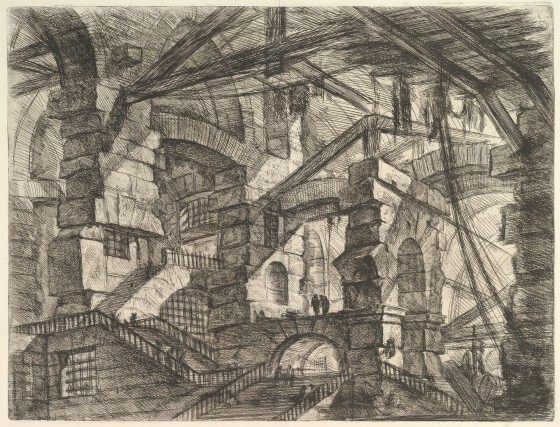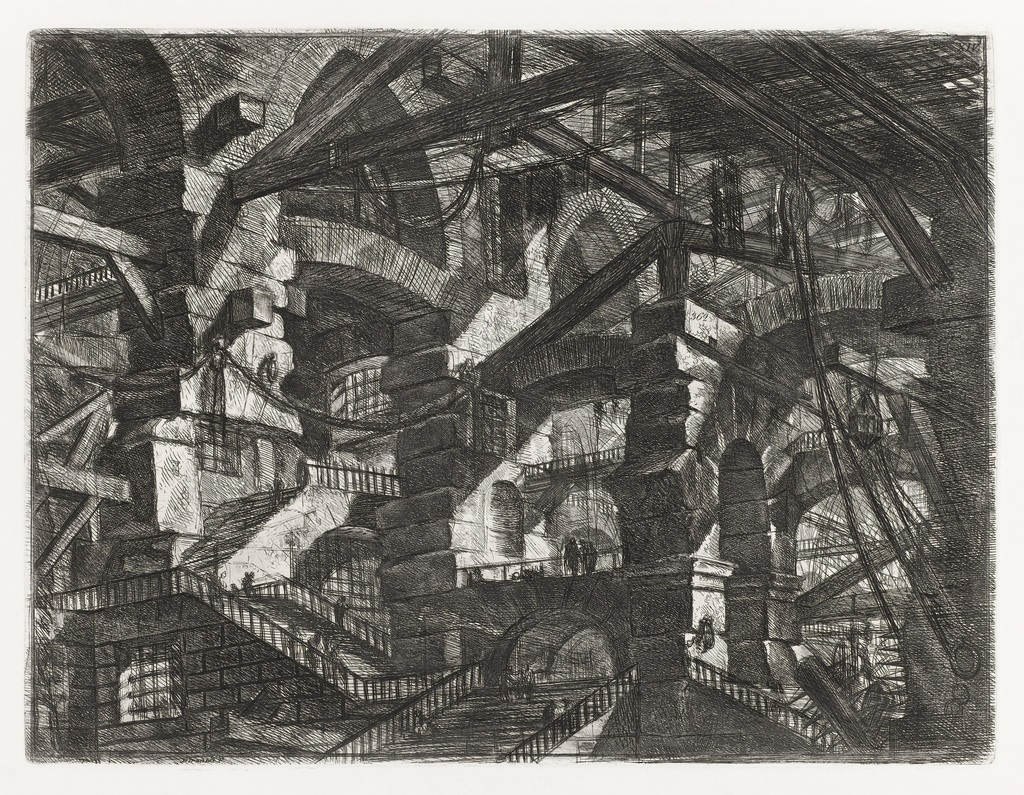Prison design has been a topic of debate and a site for innovation, even in the eighteenth century. This etching is Plate 14 from a series of imaginary prison interiors designed by the Roman architect, designer, and print maker, Giovanni Battista Piranesi (1720- 1778). This print is both an exploration of the limits of the medium of etching and the technique of printmaking as well as a visual inquiry into architectural experience itself.
Carceri were first issued in 1745 under the title Invenzioni Capric di Carceri, with 14 plates, each plate only lightly bitten by acid. Piranesi returned to the series in 1760, reworking their tonal contrasts and compositions and publishing them as Carceri d’invenzione. The Cooper Hewitt etching is this second state. This edition was produced via a particularly complicated technique in which the plate was covered with a heavy varnish to protect the first edition etched lines with the varnishing, followed by the drawing and etching processes repeated about 10 to 12 times on each plate. Below is the earlier state of the same plate.

Print, The Gothic Arch, from Carceri d’invenzione (Imaginary Prisons), ca. 1749-50; Designed by Giovanni Battista Piranesi (Italian, 1720–1778); Printed by Giovanni Bouchard (French, ca. 1716–1795); Etching, engraving, sulphur tint or open bite, burnishing; first state of six Robison); 49.4 x 63.8; The Metropolitan Museum of Art, New York; Harris Brisbane Dick Fund, 1937, Inv. No. 37.45.3(30)
Plate XIV is regarded as one of the most complex of the Carceri, and is the only one to depict a gothic arch. The etching is a masterpiece in overstatement and displays a nightmarish network of arches, vaults, bridges, ramps, balconies and catwalks. Minute figures climb the infinitely recessing stairs. The endless labyrinth of machinery of cables, catapults, pulleys, chains and levers combine to form dense patterns, and reduce the architectural interior to pure masonry.
The Carceri is linked to Piranesi’s formative training as a stage designer, as prison scenes were common in early eighteenth-century stage sets created by artists such as Filippo Juvarra. The iconography and the printing technique of the Carceri has also been linked to Tiepolo’s Capricci and Scherzi di fantasia. However, the horror vacui and the spatial complexity of the Carceri can be seen as an exploration of the architectural experience—in this cathedral of horror, Vitruvian ornament and the hotly raging debate of the superiority of Roman vs. Greek architecture is neglected with the emphasis here on the sheer magnitude and complexity of architectural structures from a spectator’s viewpoint. This paradigm of the overwhelming power of architecture and the tension between the concrete and the decaying are themes present in Piranesi’s other engraving and etching projects.
The Carceri has also been interpreted as a prime example of Edmund Burke’s ideal of the sublime. Burke identified vastness, grandeur and obscurity as characteristics of his formulation of the sublime. The Carceri circulated literally and metaphorically across various social fields and was incorporated into visual, social and political polemics of the period and has been an influential work throughout the centuries. Artists such as Jean-Charles Delafosse, Joseph Mallord William Turner, and Louis-Jean-Desprez produced drawings after the Carceri and writers such as Samuel Taylor Coleridge, Edgar Allen Poe, William Beckford, and Victor Hugo drew inspirations from Piranesi’s immense compositions. More recently, the filmmaker Sergei Eisenstein and Peter Weiss both cite Piranesi’s Carceri series as inspiration for their projects.
Cabelle Ahn is a graduate intern in the Department of Drawings, Prints and Graphic Design at the Cooper Hewitt, Smithsonian Design Museum. She received her MA in Art History from the Courtauld Institute of Art and is currently studying eighteenth century decorative arts at the Bard Graduate Center.
